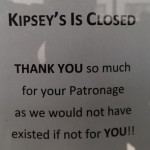CVS on 23rd street is wiped clean. Walgreen’s on 23rd and Park has some.They also have canned food.
EMP Hawks
Red-Tailed Hawk perched on the TV antenna on the roof of the A Building today!

Taken with a 400mm lens and enlarged.
Apparently a good thing since they eat rats and pigeons!
Some info:
https://twohawksnyc.com/
http://www.nycaudubon.org/red-tailed-hawks-in-nyc
https://en.wikipedia.org/wiki/Red-tailed_hawk#Relationship_with_humans
New Trader Joes!
HEAP
Hello: I am having a difficult time getting the Utility Account number to apply for HEAP. I inquired with the Management but they declined to provide it. Also, Quad Logic hasn’t helped. Kindly, any information on how to get theAccount number for my Electric bill, so that I can add it to my HEAP application. Thank you. Stone
New Plaza design
The new plaza design obviously took a great deal of work and has some amazing and beautiful features.
I don’t understand why we are dedicating so much of the main plaza to a playground.
There are not that many children at EMP. The large majority of shareholders are older and do not have children. It seems we are catering to this small group but not offering so much to adults.
Our existing playground is small and in a closed-off area. Having the playground in the main plaza creates a noise problem for anyone facing the plaza. The sounds of screaming children (an acquired taste, for sure) will echo around the plaza.
Why do we want to attract lots of neighborhood children to our property?
There is already a new mini-park and play facility on Asser Levy place less than one block away.
We will have security and liability issues having this large play facility here. We also run the risk of attracting sex offenders.
One co-operator made a great point at the plaza presentation meeting when he noted that while he likes kids, he wouldn’t buy a house situated next to a playground.
Perhaps a scaled-down playground would be far more appropriate.
While the proposed design for the park is lovely, I am concerned it will be costly to maintain. The plaza should be low maintenance both from a security and upkeep standpoint.
New Plaza
Kipseys closes
NY Times article re: Southbridge leaves Mitchell-Lama
Click here for NY Times Article
My Letter to the Editor:
Your article “Divided by a Windfall” in the on November 16 Real Estate section seems to call out the pro-privatization co-operators of Southbridge Towers as profiteers getting a windfall at the cost of affordable housing. What your article neglects to mention is that going private is the natural, planned evolution of a Mitchell-Lama co-op. The law under which the Mitchell-Lama program was created gives the right for Mitchell-Lama co-ops to buy their way out of the program after 30-40 years. The reason for this is that it was understood that buildings of a certain age start to require expensive repairs and the low maintenance scenario no longer works if the building is to be self-sustaining. If buildings stay in the program, the residents will become subject to steep assessments for repairs like new windows, roofs, major repairs, etc. or the building will become derelict. An example of this is Co-Op City in the Bronx where the garage has crumbled and been closed for years since they do not have money to make the repairs. With the crisis of revenues for local and state governments, the governmental agencies that oversee the Mitchell-Lama properties no longer have funds to make low-interest loans to buildings that cannot afford their own major repairs.
The intent of the brilliantly conceived Mitchell-Lama program in the ’50s was that the monies received by the government agency from Mitchell Lama co-ops that buy out of the program is supposed to be used to build new Mitchell Lama projects and thus keep new, self-sustaining affordable housing stock coming into the market. This has never happened. Buildings going private also contribute more to the tax base as they no longer are eligible for tax breaks.
Buildings buying out of the M-L program impose flip taxes on the first sale of a unit of anywhere from 30 to 45%. These funds go to the co-op and are used for repairs and to keep maintenance reasonable.
Forcing Mitchell-Lama co-ops to stay in the program will result in buildings that cannot do necessary repairs and that eventually will become eye-sores or crumble into the ground. Residents that think that their low maintenance will continue in a building that stays in the Mitchell-Lama program past the sell-by date will face huge assessments to make necessary repairs to an aging property.
The choice to leave a Mitchell-Lama program is a right that was guaranteed by law. Politicians blocking buildings from exercising their right in the name of affordable housing are denying people their legal right. If these politicians want to support affordable housing, they should comply with the Mitchell-Lama plan, encourage buildings to follow the natural evolution of buying-out of the program and use the funds to build new Mitchell-Lama projects as was the intention of the plan. These same politicians should also not let every 6 story, rent-stabilized building in Manhattan be knocked down by greedy real estate developers to put up luxury, high-rises that no one can afford except wealthy foreigners. The tenants of the few remaining Mitchell-Lama co-ops should not bare the brunt of the city’s failure to maintain affordable housing stock.
Polls
POLL: For/Against Insurance By-Law
POLL: For/Against Privatization
This is an information-only poll. The results are non-binding and will be presented to the EMP Board of Directors. Please only vote once.
Insurance and Obstructionists
Once again, a group who I have to assume is associated with the Anti’s is obstructing the work of the board and fighting anything that will benefit East Midtown Plaza.
I was not a fan of the board’s amendment to force cooperators to have property and liability insurance due to the additional costs to be borne by the cooperator. Upon gathering information, I realized that this action, although sure to be unpopular is beneficial to East Midtown Plaza and cooperators. The original Occupancy agreement states that the cooperator is responsible for water damage. This means that if there is a fire and the fire departments comes and sprays gallons of water in your apartment or an adjoining apartment, the water storage tank on the leaf breaches or one of our 40+ year old steel pipes springs a leak, the tenant may be responsible for tens of thousands of dollars in repairs. Without adequate property insurance, this will come out of the cooperators pocket! Forcing the cooperator to have insurance in place will also prevent the cooperator from coming after EMP for these repairs thus saving our co-op time and money to defend lawsuits.
Additionally, forcing the cooperators to have liability insurance will probably reduce EMP’s insurance premiums.
All good, right?
But once again the obstructionists have found a lawyer to comment on what they claim the board has improperly done and probably will file a suit against EMP. Every year at the EMP annual meeting, one or more of the anti’s gets up and complains about the high legal expenses. Don’t they get it that if the anti’s didn’t fight everything the Board does or the overwhelming majority of your neighbors want, EMP would not incur huge legal bills to defend the suits the obstructionists bring?
There will always be dissenting opinions on any decision. If a small minority fights every decision the majority-elected board decides on, the only result will be nothing getting accomplished.





